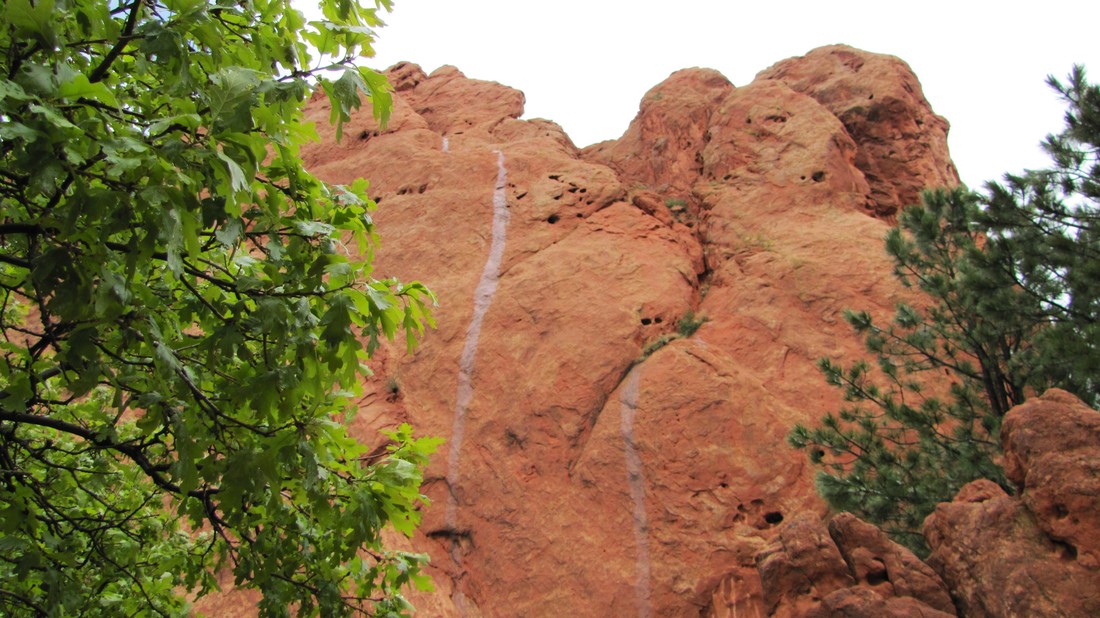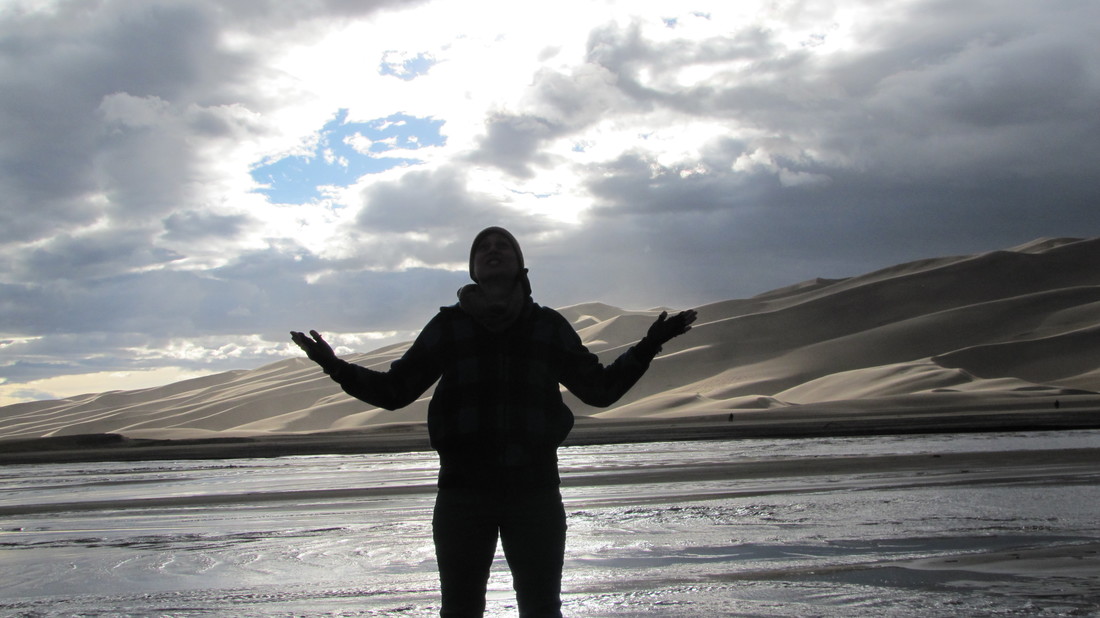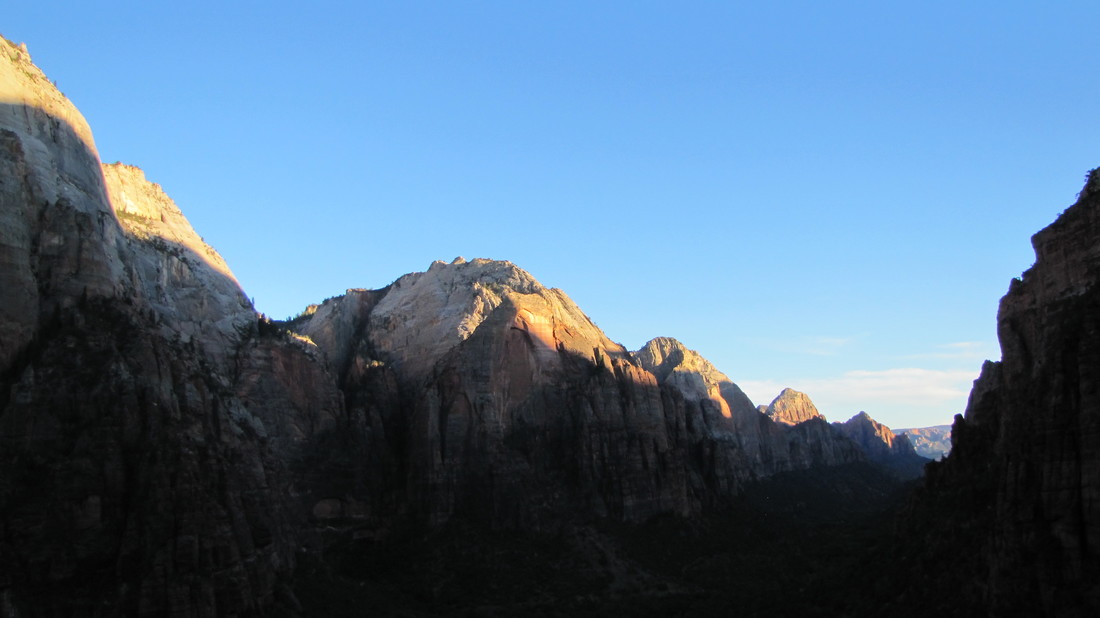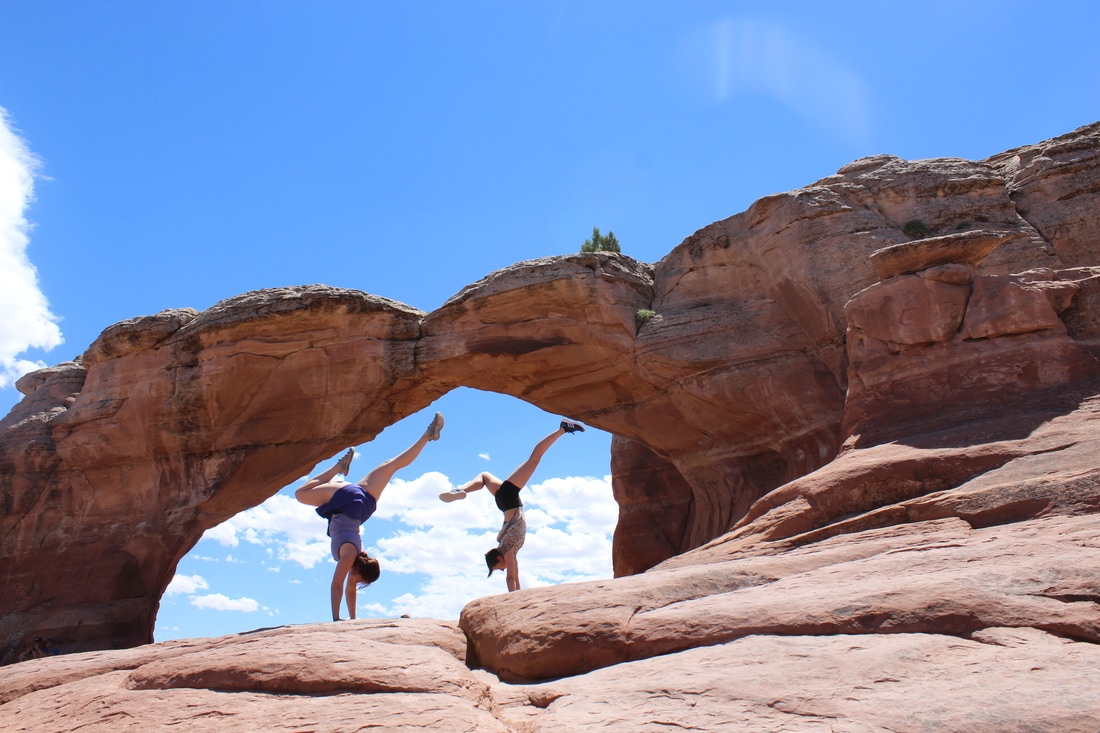|
It’s not often that one gets to step outside “normal life” and view the earth from a different perspective. This is why I am eternally grateful to share this vantage, hoping to inspire fellow earth-dwellers to follow trails. May enduring grace be bestowed upon my loving friend Jess Flying Yogi, and her family Terence, Tessa, and Geevee for their openness, generosity, and companionship on this journey. -- We left early, stuck in traffic on our way out of town. We spent our extra moments in the car going over lists of things we may have forgotten… prescription drugs, food items, pillows and warm layers. A full day of driving landed us in a hotel room just into Colorado; the next day had us driving through a snowstorm in Denver. It seemed our first picturesque views were to be obscured in thick blankets of white dust. Determined not to miss destinations due to weather, we persevere toward our first stop, Garden of the Gods. This land was bestowed on the city of Colorado Springs in 1909 through an incredible act of philanthropy. The children of Charles Elliot Perkins gifted it in his memory, with the agreement that it forever be free -- reminding us that freedom is land’s natural state. The weather clears just as we arrive, and the view from the visitor center parking lot is stunning. We take a quick check-in at the nature center for Junior Ranger books for Tessa and Geevee [this parks program is a genius way to build curiosity and future stewardship of the land]. From here we find our hikes, and proceed happily into the land of the Gods. Greeting us is a happy melty snowman -- a message that even in the cold, there is beauty in playing outdoors. Later that day, we head to Great Sand Dunes National Park, one of my favorites to photograph. Sinuous peaks of sand rival nearby snow capped mountains in their grandiosity. To reach them, we must pass through an ice cold mountain stream. After mounting the first big dune, I lie in a basin to warm up and view the world upside down while considering the perpetual hill of sand. I climb farther. The views are worth it. Even now, the surreal environment speaks of epic escapes and the test of human will to transcend barriers. Melting into nothing with each step, efforts dispersed in tiny grains of sand, the Dunes dare you to take in their true scale, to feel your insignificance. As we travel toward Monument Valley on our third day, we pass Bears Ears National Monument, one of our country’s newest national parks. You may have heard of it due to speculation about its protective designation being revoked with the current administration. We have too many miles to go to our campsite, so we continue on hoping that someday we will travel back to see that it has remained protected. As I mentioned, we are on our way to Monument Valley, the most majestic place I’ve been. We choose to stay at The View Campground on Navajo Nation land, and here we ask permission to set up our aerial rig to train. Permission granted. Happy Dance. We are told to rig in the day lot, since it is already close to sunset. The light and the Monuments’ still beauty make these shots, and our experience, one of the highest highs of the trip. I find myself at a loss for words for this place; all pales in comparison to simply beholding. Our images are a reminder that culture and nature can coexist in harmony, if only we work for it. I wake at sunrise to see the dawning of a new day, soft light, nascent forms. We stop briefly on our way to see dino tracks on Navajo land, evolution’s footprint, triggering limbic reminders of nature’s creation and destruction. Then on to the Grand Canyon, an iconic view of US wild west grandeur, co-maintained by the Grand Canyon National Park, the Kaibab National Forest, Grand Canyon-Parashant National Monument, the Hualapai Tribal Nation, the Havasupai people, and the Navajo Nation. As far as the eye can see there are canyons [Approximately 277 miles long, 4 to 18 miles wide, and over a mile deep, carved by the Colorado River]. The view flattens at a distance so the landscape looks painted. I contemplate the heyday of panorama paintings, mid-19th century, and wonder if the awe they inspired is similar to how people perceive these sights. We choose dispersed camping just outside the park, and are happy with the serenity of our site. The next day we descend a few miles into the canyon at Hermit’s Rest, the far side of the red loop, away from attractions. Our afternoon and evening take us to Lake Powell and another low-maintenance, but highly beautiful open campground. We enjoy the sunset, the warm winds, and the morning light that follows. Once again, aerial commences with ease, surrounded by water, draped in silks. Side stop at Horseshoe Bend. Handstands on the ledge. [This is nothing new… pretty much every site we visited, we took the time to shift our perspective and challenge our comfort with heights.] Forward to Zion National Park. Taking in the sights from the back seat of the Santa Fe, I see a group of big horn sheep on a ledge above us. Just as I mention them, we five scream “AHHHHHH!” in unison, bursting into nervous laughter as a big horn sheep (mistaken for a goat) jumps in front of our moving vehicle. Feeling thankful to have averted disaster, we are enthusiastically on our way toward Angel’s Landing through Refrigerator Canyon, a trail that takes you up 21 of Walter’s Wiggles (i.e. switchbacks) toward an exciting climb that involves scaling and rock-hopping using chains bolted to the mountain’s path. The whole crew endures quite well, and Jess and I leave the girls with Terrance at a landing where the climb becomes quite challenging. We are happy to continue on to the top, and have both chosen to wear dresses for the occasion. We make it, in style, and Jess proceeds to handstand at the top. The next morning we arrive at Bryce Canyon National Park, and commence our third day of major canyon hikes in a row. My calves are feeling it, but the hoodoos of Bryce are captivating!! We make it from top, to bottom, back to top again, feeling tough and challenged, and filled with light. Utah. So many rocks, so little time. We spend two days in the vicinity of Arches National Park and Canyonlands National Park, first camping in Moab and then Dead Horse State Park. Arches is nature’s cathedral, the world’s largest accumulation of natural arches. Epic vaults, literal tons of rock suspended so delicately that it’s hard to believe they were formed over 300 million years from a salt bed. Arches, spires, sandstone fins, and eroded monoliths call to the human body, as if the earth is reaching its dirt hands out to grasp us, to point to the sky and say “BEHOLD, focus your attention on THIS, or risk losing out on details trying to grasp the vastness of space.” We gaze. We juggle. We handstand. We venerate. We come back a second day. DEAD HORSE POINT STATE PARK and CANYONLANDS. The story behind Dead Horse Point’s name taps my tiny human desire for narrative. According to the story, wild horses occupied the North American landscape more than 50 million years ago. Wiped out by the last Ice Age, modern horses returned by way of the Spanish in the 1500’s. Fast forward 300 years, when wild mustangs ran free along the mesa tops... at a time when cowboys sought to profit off them. They used Dead Horse Point to trap horses and sort the healthy, marketable ones from the “broomtails”, those deemed less desirable. You can probably guess at what happens next. Legend has it that a band of broomtails was left corralled at the point, dying of thirst within sight of the Colorado River. The gravity of this tale stirs up deep sadness and anger, both past and present, at humanity’s casual lack of respect for natural life. I believe that the horses left some part of their unbreakable spirits here. Our campsite is magic. A kit fox greets us there. We rig aerials near the canyon ledge at sunset, and this is one of my favorite moments from the trip. We visit Canyonlands and see where a meteorite created a giant gorge of green silt. It seems one of the overarching themes of our trip is to be humbled by the power and strength of natural forces, as big as the cosmos, as small as a grain of sand. We traverse vast sheets of slick rock to more canyon views. We have many miles to go, and not nearly enough time to take in what this setting has to offer. By the next day we are in the Rockies, stretching our legs with a short mountain hike, much different than what we’ve grown accustomed to. The air is cool and crisp, the earth moist and covered with evergreens and snow. Bathed in forest light, we see our last views from high on the mountain. We are humbled. Leaving newly revealed parts of ourselves in mountains and canyons, we head east -- hoping to return soon. Sarah Muehlbauer
www.lionorfox.com
0 Comments
What are the boundaries of “circus”? Is it defined by its apparatus, its history, a set of forms? Do we accept and demand a certain type of virtuosity or overarching structure? Can circus appreciate small moments on par with spectacle? Could it be framed as an outlook… a mission to transcend human limits? Anandam Dancetheatre, Toronto’s cutting-edge collective entity under the direction of choreographer Brandy Leary puts the term “circus” to task, creating work that occupies disciplinary grey spaces. Rightfully so, with grace and force the company draws from a deep well of eastern philosophy and movement, earned through Leary’s significant intercontinental immersion in Indian culture. The company’s aerial rope-infused theater resists traditional classification, often assembling large ensembles and a minimalist aesthetic that connects ground and air, while experimenting with technology, light, and sound; site-specificity; and alternative audience engagement. To understand the heart of this work one has only to look to its linguistic roots. “Anandam” is Sanskrit for “liminal bliss,” but more accurately this is a space prior to awareness, as Leary describes, “Before the brain makes any kind of rational or concrete judgment.” Operating out of Collective Space, an intimate rehearsal space and venue, the company recently co-hosted Toronto’s third Contemporary Circus Arts Festival withA Girl in the Sky Productions, manifesting a consciously broad-minded view of what circus is and can be. Polish is not always the goal, setting Toronto aesthetics apart from nearby circus magnate Montreal. While the latter puts youth and acrobatic athleticism atop its formal pyramid, it is clear from the scene in Toronto that virtuosity is an entirely different animal—deconstructed, layered, valued as heavily as concept and artistry, and evaluated by the communicability of its embodied form. All involved, one would hardly argue that Anandam’s work is not spectacular. Recent project Cascade overtook the former site of the Toronto Circus School, The Globe and Mail Press Hall, installing 60+ independent rope artists in a duration based exploration of the slow act of falling, held for the length of festivalNuit Blanche Toronto. Featuring a unique disco-ball projection scheme by collaborator Eamon MacMahon and meditative score by composer James Bunton, the work cultivates a peaceful immersive space where one could get lost in the micro- and macrocosm of human form as it generates and harnesses mysterious internal force.
Just a month later, in collaboration with Ricochet’s Laura Stokes, Anandam debuted new work Seismology exploring the body and landscape through glacial imagery, creating seismic relationships that consider “states of density, collaboration, falling, collapsing, overpopulation, environmental disaster, mass graves, icebergs, and melting ice caps in an immersive theater environment.” (From Anandam's Website). One gets the sense that Anandam’s work reaches far beyond movement, using performance to transcribe human drives and universal phenomena. We are invited into the mythic, the spiritual and esoteric, led by shamanic emissaries crossing divides of discipline and culture.
One of the strongest threads in the company’s work is its enhanced, often participatory viewer experience. Beginning with Seismology and continuing through several new projects, Anandam has chosen to engage a unique “Audience in Residence” program supported by the Metcalf Foundation. This allows the company to evaluate audience relationship through continual in-process feedback, which in turn changes and shapes the piece. This should prove vital for the show Weather, to be installed at the Bata Shoe Museum in 2015. In this piece, new-media collaborator Jacob Niedzwiecki developed augmented reality applications, adding images and sound to live performance through the use of mobile devices. It’s a playful artistic hijack, welcoming the pervasiveness of modern hand-held technology and the attention-drift that accompanies it. The Bata Shoe Museum installation continues Anandam’s expanded dialogue between architecture, the body, and public space. Here Leary speaks of the fluidity of working with site that initiates a change in expectation, an opportunity for intimate moments, and a different audience that ultimately gains access to the work. In relation to theater, she comments on the challenges and opportunities of re-visioning a space, that performance in “museums, streets, and warehouses have a different life or edge to them. There’s not this over-riding context that holds it in one place and time.” Careful not to “put practices into silos,” Leary emphasizes the importance of cross-genre training and artistic viewpoint. Her education received in India was invested in the “experience of your body in the work”, rather than “viewing the body-as-machine, as a form to be exercised,“ says Leary. "This comes from a place of “ritual, myth, and spectacle, where the cosmology of the body is sacred.” Leary advocates around contemporary circus culture, while ultimately invested in the concept of a “post-disciplinary” environment. This orientation sets Anandam apart, allowing the company to occupy a unique space and presence. Adopting the tools of circus, yet going beyond perceived limits, Anandam creates work that reveres tradition while contributing to its evolution. --Sarah Muehlbauer |
Sarah MuehlbauerArtist, writer, seer, circus. Search topics through the Table of Contents to the left, or chronologically through the Archive below.
Archives
January 2021
|















































 RSS Feed
RSS Feed
